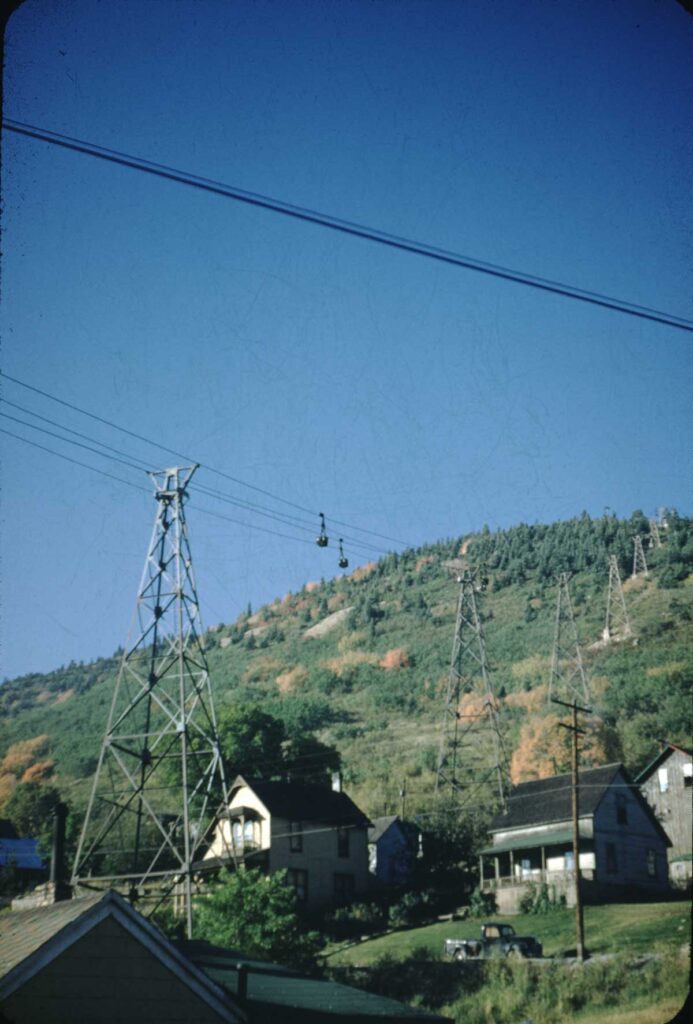In an essay called “The Hidden Life of a Miner,” Park City historian Gary Kimball recalled overhearing a couple standing outside his home on Woodside Avenue. The woman was studying a huge steel tower looming in Kimball’s yard, a rusting remnant of the Silver King Mine’s 1901 aerial tramway.
“Oh that,” her companion said. “That’s the remains of an old ski lift that was abandoned a few years ago. Those towers were just too high. Can you imagine what would happen to a skier if he fell from that thing? I bet the liability insurance was outrageous.”
The man was wrong, though the Museum still gets questions about its prior use. But there was a time, 65 years ago, when Park City’s old ore tramways actually were being considered as devices for carrying skiers.
It was 1958. Salt Lake City planning consultant M. Walker Wallace had been hired by United Park City Mines to study the feasibility of developing a resort in the mountains west of Park City. And mine management had asked him to look at the possibility of involving the old tramways.
“I kind of – like I just did – rolled my eyes in my head [and said], ‘I don’t think that’s possible, but I will find out,’” Wallace told me in a 2013 interview.
A man of many talents, Wallace had grown up ski racing in the Wasatch Mountains. He had dreams of competing in the 1948 Olympic Winter Games until they were shattered by a broken leg suffered in the Olympic trials.
Wallace went on to earn a master’s degree in city planning from MIT. But when it came to planning ski lifts, he looked up an old acquaintance, Gordon Bannerman.
As recounted in a 2021 article in Smithsonian magazine, Bannerman, then an assistant tramway engineer for the American Steel & Wire Company, had collaborated with two Union Pacific Railroad engineers to design the world’s first ski chairlifts, which were unveiled in Sun Valley, Idaho, in December 1936. He went on to help introduce chairlifts to other resorts including Aspen, Colorado in 1946 and Mad River Glen in Vermont in 1947.
“Anyway, I was able to get in touch with him,” Wallace said. “He was retired [by then]. … I was able to finally get him here and we went up to Park City and he did the same kind of double-take that I did. He looks at these tramways and he shakes his head and he said, ‘Well, boy, that’s a stretch. But let’s take a look.’”

Credit: Park City Historical Society & Museum, Mel Fletcher Collection
At that time the steel cables were still hanging from the towers of the Silver King tram. “And [Bannerman] was afraid of heights,” Wallace said. “He didn’t want to go up on any of those tramway towers. I was [also], but I was younger, so I volunteered. He wanted to get the ‘rope’ size and the number of strands and so forth that were in those cables. So I went up there, hanging on for dear life, and measured the size of the cable.”
It turned out that the old cables were unsuitable for carrying skiers. “The tensile strength was nowhere near as strong as they are now for chairlifts,” Wallace said. “I mean, they really stretch those babies [now].” And even if they had replaced the cables, he said, the towers “were not in the right relationship” to support a chairlift.
The new resort, Treasure Mountains, ultimately settled on a gondola as the main form of transportation up the mountain. However, in 1985 it opened a new chairlift, the Town Lift, that still whisks skiers and mountain bikers past the old towers of the Silver King tram. See the Wat We Were article on that here.
This month marks the 60th anniversary of the opening of Treasure Mountains, now Park City Mountain resort. Look for articles on that event spread over the next few editions of the Way We Were article series. The Park City Museum has FREE admission on Saturday, December 16 to allow locals and visitors to experience our world-class museum without a cost barrier! Free days are made possible by the Summit County Restaurant Tax Grant Program!